Posted on August 26 2024
TEER Categories for Express Entry Programs
By , Editor
Updated September 21 2024
How Canada NOC Code works?
The NOC system includes six different TEER categories, numbered from 0 to 5. These categories form the second digit of the NOC code system.
Each TEER category mainly reflects the educational and training requirements for a job. Additionally, it considers the experience required to enter the field and the relative complexity of job responsibilities compared to other roles. For instance, moving from TEER category 2 to 1 requires additional formal education. However, advancing from category 5 to 4 can often be obtained with on-the-job training and accumulated work experience.
Each TEER category represents the typical routes for career entry in various occupations. When multiple employment pathways exist, the category most frequently identified by employers is selected. This selection is based on the occupation in question and advanced trends in recruitment standards.
|
TEER category |
Nature of education, training and experience required and complexity of responsibilities |
|
TEER 0 |
Management responsibilities |
|
TEER 1 |
A university degree (bachelor’s, master’s or doctorate) must be completed; or Have experience in a specific occupation from TEER category 2 (when applicable). |
|
TEER 2 |
Post-secondary education program of two to three years at community college, institute of technology or CÉGEP must be completed; or An apprenticeship training program of two to five years is required; or Occupations with administrative or significant safety (police officers and fire-fighters) responsibilities; or Have experience in a specific occupation from TEER category 3 (when applicable). |
|
TEER 3 |
Post-secondary education program of less than two years at community college, institute of technology or CÉGEP must be completed; or Apprenticeship training of less than 2 years is required; or Complete six months of on-the-job training, training courses or specific work experience with some secondary school education; or Have experience in a specific occupation from TEER category 4 (when applicable). |
|
TEER 4 |
Completion of secondary school; or Require several weeks of on-the-job training with some secondary school education; or Have experience in a specific occupation from TEER category 5 (when applicable). |
|
TEER 5 |
Short work demonstration and no formal educational requirements |
*Searching for jobs in Canada? Find the right one with the help of Y-Axis job search services.
How do you find your TEER system using the NOC code?
You must first know your NOC code under the new 2021 system to find your TEER level.
If you know your NOC code under the old system, you can now find your new code using Statistics Canada’s Correspondence Table.
Find your NOC Code
NOC code can be found by searching the NOC matrix from your industry or by keywords like your job title. Ensure that the lead statement matches your job description and that you perform the duties and responsibilities listed under the NOC code.
Read more...
What is my NOC code for Canada?
Concentrate on the NOC exclusions also. If your occupation matches a specific NOC code but also matches one of the NOC codes that is listed in an exclusion, you cannot claim that occupation. Whichever NOC code you claim, you should prove that it is correct by providing reference letters from your past employers. If your occupations match multiple NOC codes, you must choose which best suits your experience. Remember that the visa officer evaluating your application will have in-depth knowledge of the NOC matrix. They may refuse your application if they decide that your occupation suits a different NOC code.
Once you have found your NOC code, you can determine your TEER code by looking at the second digit of your five-digit NOC code. For example, the code for Web Designer in 2021 is 21233. This occupation falls under TEER 1 because the second digit is 1.
If your occupation may be eligible for Express Entry, you must meet certain additional requirements to apply for it.
*Willing to work in Canada? Y-Axis will help you in step by step process.
What is a Reference Letter?
A letter of reference written for Canadian immigration is different from the reference letter you are writing when applying for a job. Instead of recommending you as an employer, your letter of reference needs to verify that you worked for an employer for some time and that your position matches your chosen NOC code.
The reference letters that you provide allow the visa officer to calculate how much work experience you have and at what skill level. Since work experience is a significant factor for most economic immigration programs, your letter of reference quality can significantly impact your application. Suppose the visa officer is not convinced that your reference letter is genuine or is missing some information. In that case, the officer needs to assess the validity of your work experience and decide whether to reject or refuse your allocation.
Eligible TEER Categories by Express Entry Program
Below is a comprehensive list of eligible TEERs for each Express Entry Program
|
Eligibility criteria |
Canadian Experience Class |
Federal Skilled Worker Program |
Federal Skilled Trades Program |
|
Type or Level of work experience |
Canadian work experience in an occupation listed in 1 or more of these NOC TEER Categories: |
Work experience in an occupation listed in 1 of these NOC TEER Categories: |
Work experience in a skilled trade under key groups of TEER 2 or TEER 3: |
*Are you looking for step-by-step assistance for Canada Immigration? Talk to Y-Axis, the leading Overseas Immigration Company.
For the latest updates on Canada Immigration, check the Y-Axis Canada Immigration News Page.
Tags:
Express Entry Programs
Work in Canada
Migrate to Canada
Work in Canada
Canada work visa
Canada Immigration Update
Canada Immigration
Jobs in Canada
Canada Work Visa
Share
Options for you by Y-Axis
Get it on your mobile
Get News alerts
Contact Y-Axis

